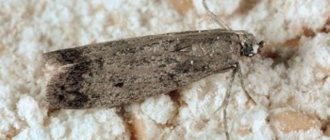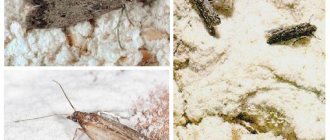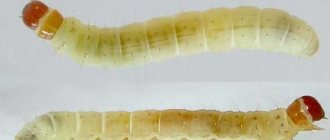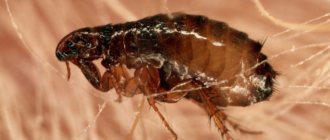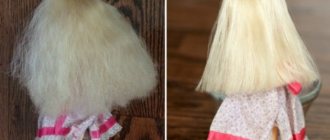- Posted by Svetlana Grishkina
- Date: December 14, 2018
Every housewife takes care of preserving food in her kitchen. But as soon as you give in, a dangerous enemy will appear in your kitchen cabinets - food moths. This harmful insect settles in cereals, flour, dried fruits, bread, making the products unfit for consumption and multiplying rapidly. If you notice food moths within your apartment, immediately start fighting it, and we will help you with this.
- 2 Reasons for appearance
- 3 Let's start destruction
3.1 Household moth control products
- 3.2 Folk remedies
Description, reproduction and lifestyle of the pest
The moth has an inconspicuous appearance and is small in size. The length of the wings rarely exceeds 10 mm. They are characterized by a discreet color - dark gray, brown or beige. Mainly nocturnal in the kitchen.
Butterflies do not need food; they only need water to survive. The adult individual loses the ability to digest food, its main goal becomes laying eggs and preserving its offspring. Food moths have an accelerated reproduction period—two months. High humidity and a temperature of at least 20°C provide a favorable environment for the life of the parasite.
The life cycle of a moth is on average ten days, but this time is more than enough for it to breed a huge number of new pests. The larvae of food moths are small - 1-1.5 cm long. These are white-yellow or pink caterpillars, absolutely smooth, without hairs or growths. They are the ones who cause the most damage. Caterpillars eat food, leaving behind webs and waste products. Pellets form in cereals, and worms appear in nuts and dried fruits.
Not only food moths, but also clothes moths can appear in an apartment. You need to understand how to distinguish them from each other, this will help you quickly find the source of infection. The clothes moth is slightly smaller than its counterpart and has milky-gray wings. He lives in closets and wardrobes, eats clothes, furniture upholstery, and carpets.
It is necessary to get rid of moths immediately after detection, since the worms cause significant damage to food products and multiply at enormous speed.
What garden flowers help?
Even flowering plants that are common in garden landscape design can become an effective tool in the fight against mosquitoes and other blood-sucking insects. The main thing to consider is that flower beds with them need to be placed in such a way that residential areas and recreational areas are protected. A good solution would be borders and borders made from such flowers. The most popular natural mosquito repellents in this category are worth taking a little closer look at.
Feverfew
This plant is better known to gardeners as Dalmatian chamomile. It is presented in a wide variety of varieties - from “Golden Ball” to “Troubadour”, it is very decorative, and is a natural insecticidal agent. Most modern synthetic drugs used to combat insects in agriculture or at home have been developed based on pyrethrum. Depending on the type, the height of Dalmatian chamomile shoots varies from 5 cm for dwarf varieties to 1.5 m for tall ones.
Some of the benefits of this natural repellent include:
- harmlessness;
- decorativeness;
- frost resistance;
- long flowering period;
- low maintenance requirements.
Insects have no natural defense against its characteristic aroma; they simply do not appear in places where this plant is planted.
Lavender
Luxurious, demanding planting conditions, this plant feels best in the Mediterranean climate. Blooming lavender has a unique aroma that can not only repel insects, but also improve sleep and calm excessive nervousness. In central Russia, it is recommended to grow it not in open ground, but in flowerpots, removing it for the winter. In the southern regions, it thrives in open ground and becomes a true decoration of the landscape in landscape plantings.
Marigold
These flowers can be called a frequent guest of garden beds. Bright buds of the most cheerful shades appear on the shoots until late autumn. The essential oils contained in the stems and leaves act as a mosquito repellent. Marigolds are also used for other purposes. Their flowers are used to make marinade and added to tea and other drinks. The plant has a pronounced antibacterial effect; cut stems can be added to bouquets to repel insects in the house.
Varieties of moths
There are several types of home moth; each group gives preference to its favorite product, but does not neglect others. There are eight main types of household pests.
- Flour moth. The firefly is small in size with beige colored wings. This type of insect reproduces faster than its counterparts. If you notice small cocoons in the flour, it means that the parasite has entered the house. Sift the flour through a sieve, then cook in the oven for at least half an hour. Store flour in an airtight container.
- Grain moth. A firefly with narrow wings of a yellowish tint, the color is similar to the color of grain so that it can blend in with it. She focuses on buckwheat, rice, rye and wheat. The safest way to get rid of the parasite is to use special traps.
- Mill moth. A butterfly up to 1.5 cm in size, with dark gray dotted wings. This type of moth is rarely found in apartments; they are usually found in mills.
- Potato moth. A small, inconspicuous moth with gray wings and long antennae. The larvae like to attack old potatoes, as their tubers are softer. They bite into fruits, causing rotting. You can fight potato moth by adjusting the storage temperature of root crops below 0°C. For a better effect, tubers can be treated with biological preparations.
- Onion moth. Wingspan up to 17 mm. The body and fore wings are brown, the hind wings are gray with fringe. The larvae eat the onion, causing the vegetable to rot.
- Cereal moth. A butterfly with silver-gray wings, the span of which reaches 14 mm. The larva destroys cereals and seeds, gluing the grains into pellets using a web. Its appearance indicates that the grain has already been stored in the warehouse.
- Chocolate moth. Eats coffee, cocoa beans, chocolate and other “confectionery”. She makes passages in chocolate products, leaving behind grains of feces. The size of the worms does not exceed 0.5 cm, so they fit into the smallest holes in the wrapper.
- Fruit moth. The gray butterfly, approximately 10 mm in size, is nocturnal. Moths grow in dried fruits, fruits and mushrooms. Its larvae break through canals, turning the fruits into dust. The insect does not disdain other products, so you can see moths in walnuts, almonds or hazelnuts.
In the apartment, food moths eat all grocery products. Therefore, first check for caterpillars:
- cereals;
- pasta;
- beans;
- peas;
- flour;
- sugar;
- candies;
- nuts and dried fruits;
- bread;
- cookie;
- spices;
- tea;
- coffee;
- cocoa;
- animal feed.
Different types of parasites can easily live next to each other. Therefore, when you find a moth, carefully check not only your food, but also your wardrobe.
Industrial solution to the problem
If we take into account that traditional methods only help to repel insects, then in order to destroy pests, it is necessary to resort to specially developed preparations. In this case, you can quickly and permanently get rid of annoying parasites.
You may prefer aerosols or sprays that do not pose a danger to people and warm-blooded animals, but are harmful to insects. Spray the contents of the bottle on the cabinets, and you won’t have to worry about the safety of your belongings.
Causes of appearance and damage caused
Where do food moths come from in an apartment? The appearance of the pest is not associated with carelessness and sloppiness of the owners. The firefly is a poor flyer; it cannot move long distances. When the caterpillar transforms into a pupa, it crawls to the far corner and waits there for its transformation.
In the warm season, moths can fly into a private house from the street through a window or an open door. It gets into the apartment along with groceries from the store, or crawls through the ventilation from neighbors. Similarly, it starts in grain warehouses, where the largest number of larvae are noticed. Infected cereals are transported from one barn to another, where the larvae immediately begin to destroy the products.
Groceries affected by caterpillars become unfit for consumption. Large warehouses suffer huge losses from food moth infestations. Food stocks in barns cannot be sold. When multiplying, the larvae leave droppings, scales and remnants of cobwebs in the rump. These waste products are toxic, they are harmful to humans, as they can cause severe poisoning.
Very often, unscrupulous manufacturers try to sell contaminated products at low prices. By purchasing a product at a discount, you can not only throw money away, but also bring home a malicious pest.
Video on the topic
Ecological flavor
If store-bought air fresheners scare you with their chemical composition, use natural products. To do this, take a small handful of dry laurel leaves and set them on fire on a glass surface.
The popular bookmaker has released a mobile application for Android, you can follow the link absolutely free.
From the editor ! This incense was used by the Ancient Romans. It was believed that along with the disappearance of unpleasant odors, the unclean spirit also left.
You can place laurel leaves on shelves in each room so that the concentration of aroma is dispersed throughout the house.
To prepare an air freshener for the toilet, you need to pour laurel leaves with hot water and let it brew for 1-2 hours. Then pour the cooled mixture into a spray bottle and spray the restroom after visiting.
How to get rid of food moths in an apartment
Fighting parasites is a rather troublesome process. To get rid of food moths in an apartment forever, all control methods must be used in combination. You should find the source of infection, destroy it, throw away all spoiled groceries and process products that may be contaminated. There are five ways to minimize harm and exterminate the pest.
- Throw away contaminated food. Check all groceries for pests. If you are in doubt whether a product is affected or not, it is better to throw it away than to torment yourself with an eternal struggle with moths. Be sure to check the packaged products - polyethylene is not a hindrance for the larvae.
- Do the washing up. Using laundry soap, thoroughly rinse all containers in which the affected cereal was stored, including adjacent jars.
- Clean out the cabinets. Wipe doors and shelves with vinegar; its pungent smell will repel moths. If the infection was global, treat the interior walls of the furniture with special aerosols.
- Process the cereal and cans. Calcine the cereals in the oven at 80°C, or put the cans of grain in the freezer for three days. If there is a sharp change in temperature, the parasites will die.
- Pour into clean containers. After freezing or reheating, transfer food to new containers with tight lids. Place a clove of garlic in each container to repel parasites.
To avoid causing moths to appear in your apartment, do not leave fruits and berries on the kitchen table. Also, do not stock up on large amounts of groceries for future use.
Folk remedies
Folk remedies have proven themselves well as a “fighter” against moths. They have a pungent odor that repels the pest, but does not rid the food of larvae.
- Garlic. Place a couple of cloves of peeled garlic in the container with the cereal. The female will not like the acrid amber, and she will not want to lay eggs. Garlic does not affect the taste of food.
- Laundry soap. Grate the soap and mix with water. Wash all interior surfaces of cabinets, then rinse and dry.
- Vinegar/lemon juice. Wipe the walls and shelves of cabinets with vinegar, and use a brush for hard-to-reach crevices. Treat with the solution after pre-washing the furniture with laundry soap.
- Lavender. Parasites cannot tolerate the aroma of this plant. Place a couple of branches in the chest of drawers where the cereal jars are. The products will be protected.
- Citrus. The smell of oranges and grapefruits repels moths. Place citrus peels on cabinet shelves or in a kitchen drawer.
- Bay leaf. Cover all groceries with bay leaves - adults do not like this peculiar smell.
- Tobacco. He is afraid of food moths and the smell of tobacco. Place a few cigarettes on the shelves in your closets. This will scare away the female and she will not lay eggs.
- Camphor. The smell of camphor alcohol will remove the parasite from your kitchen for a long time. Dampen a cotton pad with the solution and wipe the inside walls of the cabinet with it.
Remember that treatment with folk remedies will only temporarily protect groceries from pests. Over time, the larvae will develop immunity, and methods of prevention and protection will need to be changed.
Chemicals
When the focus of infestation is strong, professional food moth repellents are needed. Chemical sprays and aerosols are considered effective insecticides on the Russian market.
- "Antimol." The spray is designed for treating kitchen cabinets. After spraying, the effect lasts for a year. Destroys moths of any kind.
- "Raptor". The aerosol helps get rid of not only butterflies, but also larvae. Raptor against food moths is valid for one year.
- "Combat". Copes with all types of moths. The spray is sprayed on furniture and in the corners of the kitchen; it is absolutely safe for pets.
The aerosol helps create a protective barrier and kill pests. It must be used strictly in accordance with the instructions. After treatment, ventilate the room well and thoroughly rinse surfaces that may have been exposed to the spray. Other drugs also help control pests.
- Trap for food moths. The Aeroxon trap, a special odorless product, has proven itself well for catching adult specimens. It is filled with pheromones that attract male food moths. Males fly to the sticky surface, where they die, stopping further reproduction. Sticky traps are non-toxic and absolutely safe for human health. The cost in retail stores fluctuates around 200 rubles (data as of January 2021).
- Repellents. These are special plates, tablets and briquettes. They contain naphthalene, the pungent odor of which repels food moths. The repellent does not destroy the pest, but facilitates its relocation to another territory.
The use of insecticides in residential buildings is not recommended. The high toxicity of these products poses a threat to humans and domestic animals.
Repellent plants
In order to drive out moths, you can use suitable plants as a repellent. The following herb will help get rid of pests:
- sagebrush;
- tansy;
- carnation;
- valerian;
- marigold;
- chamomile.
Place the plant or herb collection between things, in cabinets, on shelves and near jars of bulk cereals.
Precautionary measures
There is only one way to avoid a debilitating war with food moths - not to let the pest into the house. In addition, complete destruction of the parasite does not guarantee that food moth eggs will not appear in the apartment again. To prevent this from happening, you need to take preventive measures by following six rules.
- Examination. Carefully check the groceries when purchasing, periodically review your supplies in the future, and if necessary, dry them in the oven at low temperature.
- Sealed containers. Store grains and cereals in glass containers with tight-fitting lids.
- Low temperature. The larvae cannot tolerate low temperatures, so keep your groceries in the refrigerator.
- Ventilation. Don't forget to ventilate the kitchen.
- Safety nets. Place ventilation nets on the windows.
- Maintaining cleanliness. At least once a month, do a thorough cleaning of your apartment. This will help prevent the proliferation of parasites in time.
Do not purchase cereals by weight or in unsealed packaging. And if you have already bought it, then put the bag of grain in the freezer for a few days. The pest will no longer be able to reproduce.
Moths can appear in both a country house and an apartment. If you follow the described recommendations, then you will not have problems with how to remove food moths. In the future, do not forget about preventive measures and timely cleaning of the kitchen.
